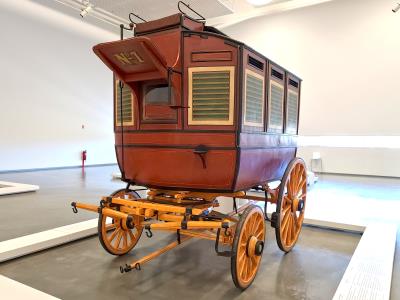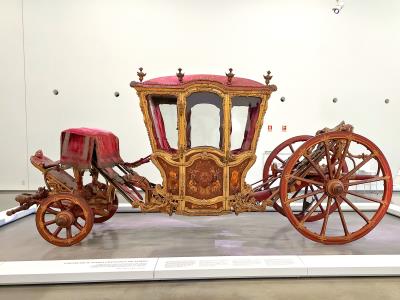Day 15 8/22/2023
Portugal - Lisbon
Frank's Trip
CLICK on any image to enlarge - use mouse cursor to move enlargement it if doesn't fit area

My All-Time Favorite Museum...
This is definitely my favorite museum I have visited; museums are good, but I'm not a huge fan - until this one. The time, artistry, and gold leaf used in some of these are just amazing.
The wealthy of today can buy very special vehicles. But allowing for inflation, it seems unlikely they could afford such coaches as many of these individual and custom made-to-order vehicles.
Prior to this I had no conception of the extravagantly beautiful coaches that were used by royalty and the "super-rich"
National Coach Museum / Museu Nacional dos Coches
The Museum is housed in an old riding school and was inaugurated on the 23 May 1905 by Queen Amélia of Orleans and Bragança, the Princess of France married to King Carlos I of Portugal.
<<< King Filipe II of Portugal, III of Spain
1619
Queen Maria Francisca of Savoy-Nemours
Carrosse Moderne type - 1666 >>>

Given by Louis XIV to his cousin Maria Francisca of Savoy on her marriage to Alfonso VI in 1666


17th Century

bombe rocaille style - 18th Century








Coach of the Crown
Part of the Embassy procession of Count Ribeira Grande sent by King Joao to the Court of Louis XIV in 1715 to re-establish diplomatic relations with several European Courts after the Utrecht Peace Treaty

Coach of the Oceans
The theme is the connection of the oceans and represents an important maritime episode of the history of Portugal. The passage around the Cape of Good Hope connecting the Atlantic and Indian Oceans. 18th Century




Conquests and Navigation
Commemorates the dangers endured by the Portuguese during the passage around the Cape of Good Hope connecting the Atlantic and Indian Oceans. 18th Century


18th Century





Coach of the Children of Palaver
Coach of the illegitimate sons of King Joao V - Princes Antonio, Ga spar and Jose. Known as the "Children of Palaver" because they lived in the palace of the same name.
Coup - 1 seat for 2 passengers - 18th Century

Coach of the Princesses
Coach of the Princesses Maria Francisca, Maria Ana, Maria Francisca Doroteia and Maria Francisca Benedita - daughter of King Jose I - 18th Century




This coach of King Jose I is considered one of the best examples of Portuguese Baroque - characterized by decoration with excessive detail
18th Century



Coche de Mariana Vitoria
Used for travel of the Spanish Royal Family for the occasion of the marriage of Spanish Princess Mariana Vitoria de Bourbon to Portuguese Prince Jose in 1789



Coche de Mesa
This "table coach" joined the procession of the Portuguese Royal Family on the occasion of the Prince to the Spanish Princess in 1729





Berlins
The Berlin is a vehicle that appeared in the city of Berlin in the 2nd half of the 17th Century. The body is set between poles and rests on wide leather straps which provides greater stability making travel more comfortable.
These Berlins were commissioned in Paris by King John V and decorated with the Royal Arms









Processional Berlin
This type of vehicle was for religious purposes - this one to transport the Image of the Virgin in the Procession of Our Lady of Cape Espichel.




These Italian style promenade vehicles are decorated with floral motifs on a golden surface and were commissioned by Queen Maria I. The Royal Family used them on their estates and in the palace gardens. These vehicles with 2 seats and 2 or 4 wheels were driven by the occupant himself or by a postillion.
2 Wheel Cabriolet
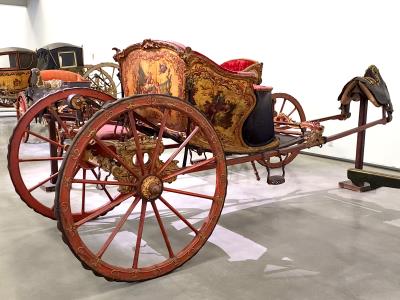
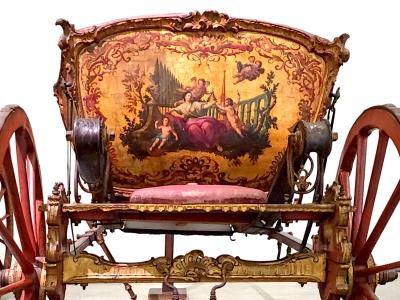

Roman Litter
Litters were used in Europe from the Roman period until the 19th Century. They were carried by 2 mules or horses harnessed to the poles fixed to the litter body. Since they were easy to maneuver they allowed quick and comfortable journeys in narrow streets where larger vehicles could not travel.



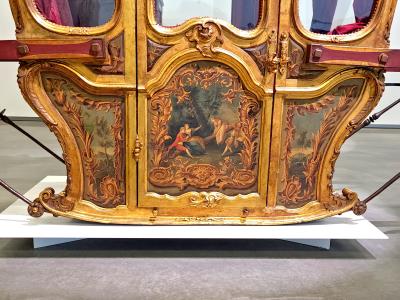
Children's Cabriolets
Small children's cabriolets were used by young Princes and Princesses to play with and for promenades in the parks and palace gardens. These could be pulled by ponies, sheep or goats.




Carriage for Children

Charabanc
This vehicle was used for promenades in the countryside or in hunting expeditions. It has a removable roof, roll-up blinds, 4 lanterns and 2 steering wheel brakes.
Commissioned in London by Queen Maria II and presents the monogram of King Carlos I


Tonneau - Governess Cart
This promenade cart was used to transport children accompanied by their governess. It has lanterns and a spring suspension and was pulled by 1 horse.
The Crown State Carriage
This Empire style carriage was commissioned in 1824 in London for King Joao VI. This was used for the King Carlos I and the body is suitable decorated.





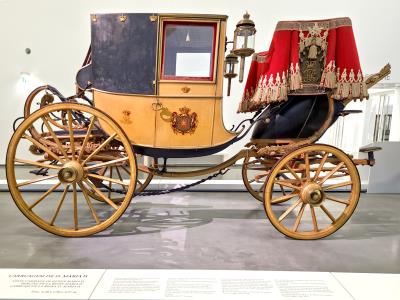
State Carriage of Queen Maria II
The Portuguese Royal Coat of Arms and the Queen's Crowned Monogram are design elements. At the back is a rounded box to carry weapons.

Calash
Commissioned by the Portuguese Royal House, this vehicle came into service after the establishment of the Republic in 1910. It has 4 seats facing each other and a folding hood. At the rear is a seat for the groom with access to a crank brake.


Mail Coach
This was used to carry official mail as well as passengers inside the body and on the roof.
It was later acquired by Gustavo Ferreira Pinto Basto for travel, promenades and hunting.

Mail Coach
This vehicle was intended for long distance travels. There are 2 passenger compartments and, between them, one for official mail. The coachman sits at roof level where the luggage is also carried.
The travel between Lisbon and Porto took 34 hours and stopped at 23 stations so travelers could rest and horses could be changed. This service came to an end with the arrival of the train.

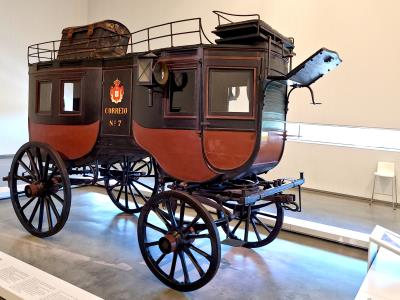


Prisoner Carriage
This is the oldest horse drawn prisoner transport vehicle known in Portugal.
6 individual cells, perforated metal plate on top to watch them and seat and door for each. 2 prison guards seated at each end of the short interior corridor.
